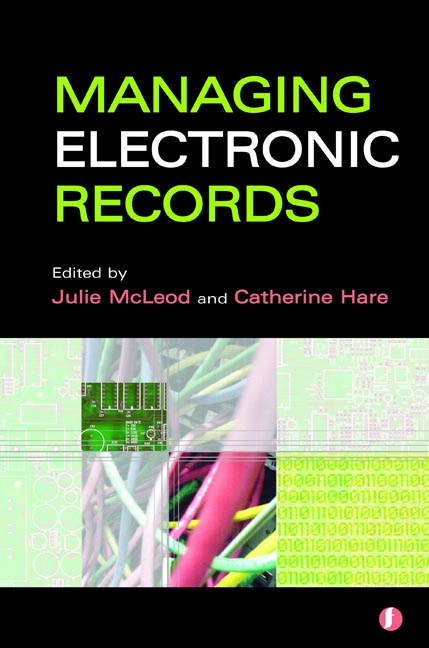Book contents
- Frontmatter
- Contents
- The editors and contributors
- Preface
- 1 The wild frontier ten years on
- 2 The use of standards and models
- 3 Metadata matters
- 4 Digital preservation – ‘the beautiful promise’
- 5 Research in electronic records management
- 6 Technologies for preservation
- 7 Legal issues
- 8 Ethics and electronic recordmaking
- 9 Competencies – the asset that counts most: on developing human talents as a prerequisite for successful EDRM changes
- 10 Records management: two case studies from the French private sector
- 11 Implementing a solution for electronic recordkeeping in the public sector
- 12 Playing the long game – creating and maintaining the links in the value chain
- Index
2 - The use of standards and models
Published online by Cambridge University Press: 08 June 2018
- Frontmatter
- Contents
- The editors and contributors
- Preface
- 1 The wild frontier ten years on
- 2 The use of standards and models
- 3 Metadata matters
- 4 Digital preservation – ‘the beautiful promise’
- 5 Research in electronic records management
- 6 Technologies for preservation
- 7 Legal issues
- 8 Ethics and electronic recordmaking
- 9 Competencies – the asset that counts most: on developing human talents as a prerequisite for successful EDRM changes
- 10 Records management: two case studies from the French private sector
- 11 Implementing a solution for electronic recordkeeping in the public sector
- 12 Playing the long game – creating and maintaining the links in the value chain
- Index
Summary
Introduction
The topic of standards is one that is viewed ambiguously, certainly in the area of information and records management where they are not at the forefront. On the one hand people scratch their heads, because standards may not seem directly helpful to them and may restrict their autonomy, and on the other they are aware that some standards are needed to enable, for instance, communication and information exchange. Some standards in the current office environment are implemented almost naturally and mostly without much thought because of the software that is used or available. The Microsoft Office suite of software and the internet protocol TCP/IP are examples of widely used de facto standards.
The growing interconnectivity and interdependency of organizations in the digital world, however, increasingly require serious attention and thought by organizations as to the consequences for their ability to do business as well as the new opportunities offered. This is strengthened by the external pressure to provide access to information resources and to become open and transparent to the public. The world wide web would then be the main and in a way mythical and virtual place where all that information could be found. In trying to address those challenges one of the decisions organizations have to make is when and where they should or want to use standards. Such standards may range from quality assurance to information security to metadata standards, as well as records management.
This chapter provides a short overview of the world of standards, focusing on records and archives management. It is important for records managers to understand where standards come from, what different types there are and why they are useful. It includes a description of the most relevant standards, but this is not and cannot be exhaustive. One related area that is not discussed for instance is that of archives which, to date, has developed its own world of standards. Well-known examples are the International Standard on Archival Description/General (ISAD/G), ISAAR (CPF) and the Encoded Archival Description (EAD) and Encoded Archival Context (EAC). Those standards are not exactly related to records management standards, though they concern the same information objects.
- Type
- Chapter
- Information
- Managing Electronic Records , pp. 18 - 33Publisher: FacetPrint publication year: 2005
- 2
- Cited by



